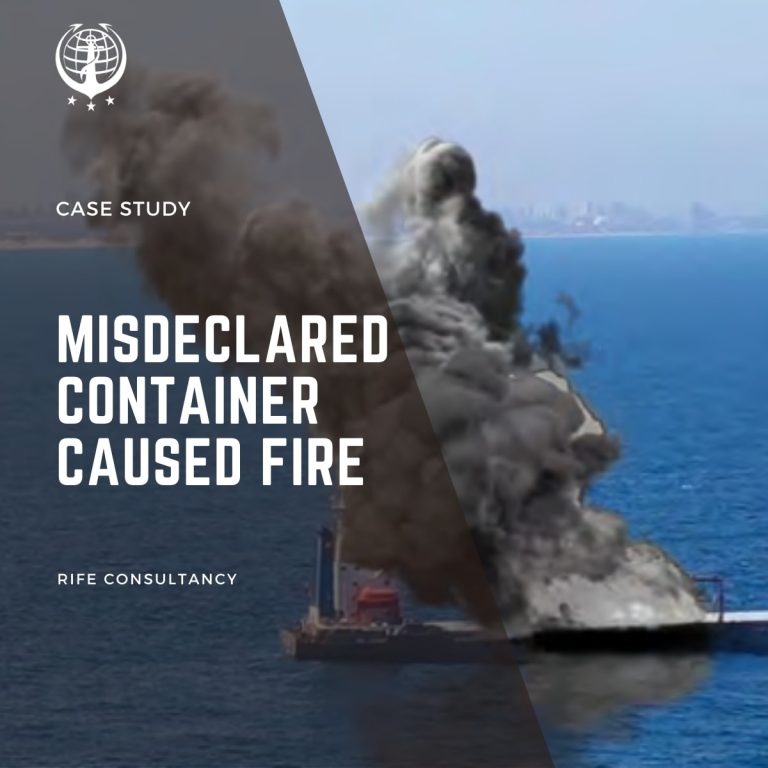
Misdeclared container caused fire – Case study
in this blog we will explore about Misdeclared container caused fire , In its recently issued Monthly Safety Scenario, the Swedish P&I Club focuses on a case where a container suffered fire due to misdeclared cargo.
Table of Contents
The incident
It was early morning, and the master could see a massive cloud of smoke coming from the vessel’s front section from the bridge. The fire detection system for cargo hold 2 sounded on the bridge at the exact moment. The smoke was white at first, then brownish, according to the master. However, the commanding officer reported the smoke as “dark grey, nearly black.”
The cargo hold ventilation fans were turned off. Although the cargo hold 2 fans were not running at the time, natural air was supplied for the holds since the vent covers were open. The vent covers for cargo hold 2 were closed, and no crew members entered the cargo hold.
Discharge of Carbon dioxide in Cargo hold 2
In the meantime, the Master guided the ship to a neighboring harbor. The Chief Engineer discharged the contents of 197 CO2 cylinders into cargo hold 2 after performing numerous tests. The complete complement of CO2 necessary for the hold was discharged, and the fire seemed to be extinguished. After a few hours, smoke began to billow from the cargo hold, and 57 more CO2 cylinders were released into cargo hold 2.
Six hours later, smoke could be seen coming from cargo hold 2, prompting the Chief Engineer to release another 57 CO2 cylinders. The following morning, salvagers boarded the ship. The vessel’s crew performed temperature checks shortly before midnight, indicating that the temperature in cargo hold 2 was increasing, prompting the discharge of five additional CO2 cylinders.
Another 15 CO2 cylinders were discharged the next morning. The salvors entered cargo hold 1 and recorded an 83°C temperature on the bulkhead to cargo hold 2. The decision was made to fill cargo hold 2 with water from the fire hydrants. The water filled three container layers, and the salvors declared the fire extinguished after a few hours.
Dangerous Cargo
The container that caught fire was not reported as dangerous goods; instead, it was laden with calcium hypochlorite, which the shipper had incorrectly disclosed. The charterer had stacked the container according to the IMDG code’s regulations. The container might have been stored in the cargo hold according to the schedule, but because the consignment contained calcium hypochlorite, it should not have been carried below deck or in the location it was placed in.
Lessons learned
Calcium hypochlorite and other oxidizing materials are examples of this type of cargo. They’re frequently used to sterilize swimming pools and cure fabrics (bleaching or washing). These materials do not oxidize, although they may contain relatively unstable compounds that slowly degrade over time, releasing oxygen. Heat can be produced by this self-decomposition.
As a result, a self-heating process might occur, in which the material at the center of a cargo body grows hotter, increasing the rate of breakdown and heating. This can cause a ‘thermal runaway,’ in which heat and gases are rapidly decomposed and evolved, occasionally including more oxygen. In hold, the results might be akin to an explosion. Fire can spread due to the heat and oxygen created.
Self-decomposition occurrences can be caused by a variety of factors, including:
- Solar radiation (before or after loading), cargo lights, and heated fuel tanks are all examples of heat sources
- Cargo formulation
- Cargo contamination throughout the manufacturing process
- Spillage and thus reaction between cargo land combustibles e.g. timber
- Insufficient heat dissipation due to an excess of goods in containers. Inadequate package separation in containers, resulting in poor heat dissipation
Click here to join our Telegram chanel
You will get information, news, and support related to Merchant Navy.
